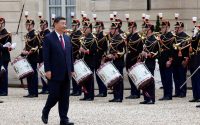Your Monday Briefing: Blinken in Beijing
Blinken arrives in China
Antony Blinken arrived in China yesterday — the first visit by a U.S. secretary of state to China since 2018 — in the hope of slowing the downward spiral of relations between Beijing and Washington.
Blinken met with China’s foreign minister, Qin Gang, for five and a half hours, one hour longer than scheduled. The two men and their aides then had a stroll together and a working dinner together for two hours.
The official Chinese summary of the meeting was bleak. Qin asserted that U.S.-China relations were at their lowest point since the start of normal diplomatic ties in 2019. He also pointed out that the Taiwan issue was the greatest risk to relations between China and the U.S.
According to the U.S. summary, Blinken said that the U.S. would stand up for the interests and values of the American people “and work with its allies and partners to advance our vision for a world that is free, open, and upholds the international rules-based order.”
What the U.S. wants: Officials have stressed that re-establishing high-level diplomacy is their priority. Security issues are likely to weigh heavily, and Blinken plans to talk with Chinese officials about global issues, including climate change and economic stability worldwide.
China’s approach: China is expected to raise a litany of grievances during the two-day visit, reflecting Beijing’s view that the U.S. is a declining hegemon determined to cling to power by containing China.
G.O.P. reaction: Leading congressional Republicans excoriated Blinken on Friday for traveling to China. They accused him of undermining national security by attempting to normalize diplomatic relations with Beijing, as they press for a more hard-line approach.
Evidence suggests Russia blew up Ukrainian dam
The Kakhovka dam in Ukraine was designed to withstand almost any attack imaginable from the outside. Evidence reviewed by The New York Times clearly suggests that Russia blew it up from within.
The dam, which is controlled by Russia, was built during Soviet times, which meant that Moscow had the structure’s engineering drawings and knew about its Achilles’ heel: a small passage underneath the dam reachable from the machine room. This passageway, the evidence suggests, is where an explosive charge detonated and destroyed the dam.
Details: Seismic sensors in Ukraine and Romania detected the telltale signs of large explosions on the day of the collapse, and U.S. intelligence satellites captured infrared heat signals that also indicated an explosion. Additionally, as water levels fell, the section that collapsed was no longer visible above the water line — strong evidence that the foundation had suffered structural damage, engineers said.
Nuclear: The top U.N. nuclear official recently visited the Zaporizhzhia Nuclear Power Plant and said that it had a “few months” of water left to cool the reactors and spent fuel rods, and that the authorities there had started to take steps to replenish the supply.
Other updates from the war:
Bangladesh’s coal-less coal plant
Bangladesh spent $2 billion to build the Maitree power plant, one of the world’s newest coal-burning power plants. It began operation in December but has sat idle for weeks at a time. The reason: No coal to burn.
Maitree experiences these temporary shutdowns because of a shortage of currency to import coal from Indonesia. The troubles facing the power plant are a glimpse into the risks that other new coal plants around the world could face in coming years, as renewable energy sources like wind and solar become cheaper.
Coal in Asia: China continues to build new coal plants, but other countries are retiring old plants or canceling new planned projects. Bangladesh, for instance, recently canceled plans to build 12 coal-burning plants. India said it would suspend new coal plant projects for the next five years.
What’s special about your hometown’s food?
I love talking about the foods of New York City, where I was born and raised. But that’s not just bagels and pizza. Instead, when friends visit me, I make them try the flavors of my New York City.
I thought about the tastes of home while reading about some of New York City’s most distinctive restaurants. My colleagues’ recommendations made me wonder: What would you all feed a visitor to give them a taste of your hometown? Why is this food special to you?
To participate, you can fill out this form. We may feature your response in an upcoming newsletter.
THE LATEST NEWS
Asia Pacific
Around the World
Golam Khan was a revolutionary during the 1971 Bangladesh Liberation War, which one expert calls “a forgotten genocide.” Khan went from being a war hero to an immigrant cabdriver in New York City. He has fought to keep the memory of the war alive in his new land, but does anyone care?
Lives lived: Daniel Ellsberg leaked to The Times a secret history of American lies and deceit in the Vietnam War, government documents that came to be known as the Pentagon Papers. He died at 92.
ARTS AND IDEAS
Egypt spars with a Dutch Museum
A new exhibit in the Netherlands explores how Black musicians — Beyoncé, Tina Turner, Nas and others — have drawn inspiration and pride from the idea that ancient Egypt was an African culture. The exhibit is framed as a useful corrective to centuries of cultural erasure of Africans.
But what might sound empowering in the U.S. and thought-provoking in the Netherlands, is anathema to Egypt’s government and many of its people, who have flooded the museum’s Facebook and Google pages with complaints — occasionally racist ones — about what they see as Western appropriation of their history.
Many Egyptians do not see themselves as African at all, identifying much more closely with the predominantly Arab and Muslim nations of the Middle East and North Africa. Many look down on darker-skinned Egyptians and sub-Saharan Africans. Some feel that their culture and history are being erased in the Western quest to correct historical racism.


